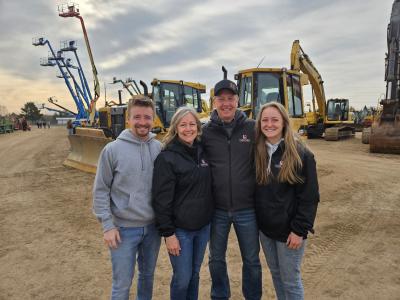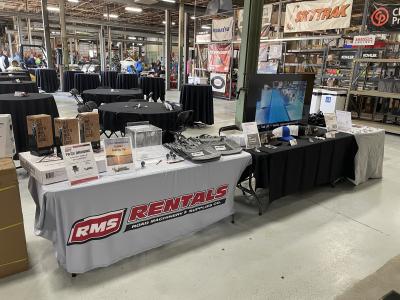Talking to Lane Construction project superintendent Cecil Dillon about the Island Falls, Maine, I-95 project takes you from a long list of challenges and demanding requirements to a great end, so much so that you want to drive there and check out the paving for yourself. If you do, you’ll agree with Cecil’s assessment — it’s an isolated area. And by the way, your eyes are not deceiving you — in that section of I-95 there’s no mainline longitudinal joint.
A Lane Construction Project
Railroad engineer John S. Lane founded the Lane Construction Corporation in 1890. Today, Lane is an innovative leader of transportation and heavy civil construction products and services, and one of America’s premier heavy civil contractors for public and private owners, constructing quality highways, bridges, locks, dams, race tracks, and mass transit and airport systems in 20 states and abroad.
We spoke with several company representatives, including Rocky Shuffleburg II who’s responsible for equipment decisions at Lane; Ken Blakely, Lane’s mechanical supervisor for the state of Maine, and project superintendent Cecil Dillon, a Lane paving specialist from North Carolina who temporarily relocated to northern Maine to oversee the project.
To our first question — In your words, what separates Lane Construction from their competitors? Shuffleburgs’s immediate reply was, “Commitment to excellence.” And he gives as a specific example how in the case of the Island Falls project, the company didn’t hesitate to pull people from all over the country.
“We built a team of experts who were specialists in each aspect of the job to make sure everything was in place to achieve top results,” he said.
A Closer Look
Island Falls project superintendent Cecil Dillon has been with Lane for nine years and as he said, “I have asphalt in my blood.” Still, he thought that the I-95 Island Falls project was different, and we wanted to hear more about the challenges and how they were handled, and of course, learn what the reasons were behind the very good results.
Dillon thinks that as it happens with every Lane Construction project, planning was crucial to the success of the Island Falls highway paving.
“Planning started two months before the first shovel was put into the ground; it was a moving jig saw puzzle and we had the pieces.” And he emphasized, again, “We had a plan A, a plan B and a plan C; there always was a backup plan.”
According to Dillon, preparation included equipment, training and staging.
“We had an excellent work force, and we utilized a paver capable of pulling two travel lanes at once.”
What Was Different About This Project?
Dillon named the weather, the isolation and a tight deadline as particularly challenging; on the other hand the use of RAP, reclaimed asphalt pavement or recycled asphalt product, as a structural layer was innovative but very successful.
“The weather was a huge factor,” said Dillon, purposefully stressing “huge,” and continuing, “We had a very wet summer, the second highest rainfall ever in Maine and of course some things cannot be done in wet weather; for example, water makes the bond between layers less adequate.” Communication was key in dealing with it, said Dillon, who said that he and the other two project managers were constantly texting each other the latest forecast or storm path.
“By the end of the project, we were all amateur meteorologists.”
We also asked how important the relationship with their equipment dealer was to them on this project, and Dillon answered, “It was critical,” continuing, “You have to trust your dealer, and Milton CAT showed us that we could.
“Blakely told how it was 2:00pm on a Wednesday, and a roller went down. At 7:00 a.m. the next day there was another machine at the job site, sent from southern New Hampshire. He shook his head and said, “Impressive.”
According to the Lane representatives, training was another important benefit that Milton CAT brought to the table. Dillon recounted how the Milton CAT team took apart the paver and put it together three times before the job began, “one time by themselves and then again with us at our shop, so we could see everything,” and they troubleshot it twice, running it without any material. But, why was it so important to check out the paver so closely and even take it apart?
“We were using the 1055E, a Cat paver with an extra long, 25 foot screed, that would allow us to do two lanes at once,” explained Blakely. “We were going to be paving in an area where frost heaves cause a lot of damage, and the extra wide screed on the 1055E would eliminate the central longitudinal seam where water seeps in.”
With the extra wide screed set-up being relatively uncommon, the Milton CAT team wanted to make sure the Lane crew was very comfortable with the way it had to be set up for best performance.
Lane personnel appreciated that extra step, “To troubleshoot it twice before even getting to the job site made a big difference; heading into the job it gave us all confidence as to what we could expect from them.”
The Isolation Factor
Other factors that had contributed to the project’s difficulty were the long distances to the asphalt plant and the fact that the area is very isolated.
“Trucking was an issue,” said Dillon, adding, “There were not enough trucks available in that area so we brought them from all over, and there were no silos at the plant for storage so we had to plan the trucking perfectly to ensure we were able to keep the plant running while not having trucks waiting idle.
“At the height of production we used 12 trucks and each truck made eight trips a day; we calculated the plant production and the time it took to complete a round trip to figure out the number of trucks we needed to maintain our optimum production.”
Each truck was loaded with a minimum of three drops and because larger trucks were utilized, the drop size was limited to seven tons.
“Since the longer the batcher doors are open, the more susceptible the mix is to segregate,” explained Dillon.
Regarding any other special segregation tips, he said that they used a material transfer vehicle sometimes called a shuttle buggy, which also works as a remixer; it’s in between the paver and the truck to feed the paver so the paver never stopped.
“There was a constant flow of material,” said Dillon. “It’s best practice to do that.”
A Successful Project and Some Knowledge Gained
Regarding the use of RAP as a lift on top of the dense graded material, he said, “The DOT proposed it because it’s green and because it was available.” Dillon added that finding suitable materials was difficult given the isolation; this RAP came from the same job — it was crushed to 1 in. (2.5 cm) max then shipped back out to the job.
“After the first half mile we realized that it was going to work really well, and actually we will propose the use of it on other jobs.
The performance of the wide, 25 ft. paver was a surprise to Dillon. I believe there is a comfort level now that wasn’t previously there,” he said, referring to the Cat 1055E paver, and the fact that the width of the paver meant that two lanes could be done in one pass, avoiding mainline longitudinal joints so no water can get in.
“There are only transversal joints and longitudinal shoulder joints in that stretch of road.”
When asked whether there was anything about the Island Falls job that opened a door about different ways of working, Dillon named the use of RAP as a structural layer; the wide paver and the rear-mounted screed.
“The crew was not happy when they heard that’s what they’d get because they are used to the front-mounted screed but a rear-mounted is better, it allows gravity to do its job with the material and the material flows and has a consistent application across. Now the crew likes it.”
He closed by adding a good reminder of the importance of the human component to assure the success of any enterprise.
“Personally I think the secret is to focus on doing every single ton as if it were the only ton you’re doing.”
The relevance of the human factor also was emphasized by Lane District Manager Rodney P. Lane.
“Lane assembled a strong team, led by Project Manager Joe Wardwell; Resident Engineer Ryan Sullivan and his group of Maine DOT inspectors did an excellent job, and Milton CAT supported the 25 ft. paving the way we knew they would.
“Let’s not forget the communities and good people of Southern Aroostook County. Their patience and hospitality were much appreciated.”
Today's top stories















